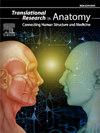A cadaveric investigation of the radial artery origin and its anatomical variations
Q3 Medicine
引用次数: 0
Abstract
Introduction
According to standard anatomical description, the radial artery typically originates as one of two terminal branches of the brachial artery within the cubital fossa. Despite the common embryological process of the upper limb arteries, there are anatomical variations in the origin of the radial artery such as the radial artery originating from the axillary artery or from the brachial artery in the arm. The present study aimed to investigate the origin of the radial artery within a select adult cadaveric South African sample.
Methods
A total of thirty adult cadaveric specimens (n = 60 upper limbs) were dissected at the University of KwaZulu-Natal (BREC/00006978/2024).
Results
The radial artery originated from the brachial artery in the cubital fossa as per standard anatomical description in 90 % of the upper limb specimens. In 10 % of the sample, the aberrant radial artery originated from the axillary artery (four unilaterally, and one bilaterally in an 80-year-old male cadaver). The aberrant radial arteries originated an average 172 ± 20.81 mm above the inter-epicondylar line of the humerus, with external and internal diameters of 5.45 ± 1.71 mm, and 3.10 ± 0.70 mm respectively.
Conclusion
This study reports an incidence of 10 % of the sample in which the radial artery originated from the axillary artery. Knowledge of the variations in the origin of the radial artery within this select South African population may assist the clinician during coronary and neuro-interventional procedures.
桡动脉起源及其解剖变异的尸体调查
根据标准的解剖学描述,桡动脉通常起源于肘窝内的肱动脉的两个末端分支之一。尽管上肢动脉具有共同的胚胎学过程,但桡动脉的起源在解剖学上存在差异,如桡动脉起源于腋窝动脉或臂动脉。本研究旨在调查桡动脉的起源在一个选择的南非成人尸体样本。方法在南非夸祖鲁-纳塔尔省大学(BREC/00006978/2024)对30例成人尸体标本(n = 60例上肢)进行解剖。结果90%的上肢标本桡动脉起源于肘窝的肱动脉,符合标准解剖描述。在10%的样本中,异常的桡动脉起源于腋窝动脉(4例单侧,1例双侧,一例80岁男性尸体)。异常桡动脉平均发源于肱骨上髁间线上方172±20.81 mm,外径5.45±1.71 mm,内径3.10±0.70 mm。结论本研究报告了10%的病例中桡动脉起源于腋窝动脉。了解这些选定的南非人群中桡动脉起源的变化可能有助于临床医生进行冠状动脉和神经介入手术。
本文章由计算机程序翻译,如有差异,请以英文原文为准。
求助全文
约1分钟内获得全文
求助全文
来源期刊

Translational Research in Anatomy
Medicine-Anatomy
CiteScore
2.90
自引率
0.00%
发文量
71
审稿时长
25 days
期刊介绍:
Translational Research in Anatomy is an international peer-reviewed and open access journal that publishes high-quality original papers. Focusing on translational research, the journal aims to disseminate the knowledge that is gained in the basic science of anatomy and to apply it to the diagnosis and treatment of human pathology in order to improve individual patient well-being. Topics published in Translational Research in Anatomy include anatomy in all of its aspects, especially those that have application to other scientific disciplines including the health sciences: • gross anatomy • neuroanatomy • histology • immunohistochemistry • comparative anatomy • embryology • molecular biology • microscopic anatomy • forensics • imaging/radiology • medical education Priority will be given to studies that clearly articulate their relevance to the broader aspects of anatomy and how they can impact patient care.Strengthening the ties between morphological research and medicine will foster collaboration between anatomists and physicians. Therefore, Translational Research in Anatomy will serve as a platform for communication and understanding between the disciplines of anatomy and medicine and will aid in the dissemination of anatomical research. The journal accepts the following article types: 1. Review articles 2. Original research papers 3. New state-of-the-art methods of research in the field of anatomy including imaging, dissection methods, medical devices and quantitation 4. Education papers (teaching technologies/methods in medical education in anatomy) 5. Commentaries 6. Letters to the Editor 7. Selected conference papers 8. Case Reports
 求助内容:
求助内容: 应助结果提醒方式:
应助结果提醒方式:


